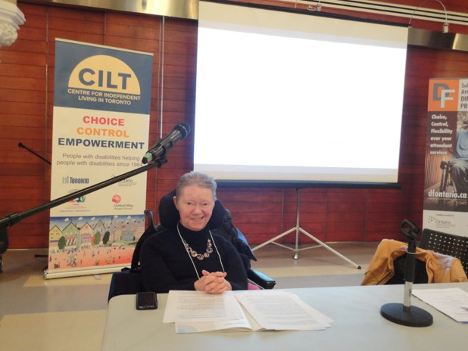A Tribute to Sandra
Jeff Noonan, University of Windsor
jnoonan [at] uwindsor [dot] ca
On January 23rd, Canada lost a leader in the struggle for equality and freedom. Sandra Carpenter was in the forefront of 1970’s disabled rights activists who demanded the right and means to “independent living.” Thousands of people have been assisted in their struggle for freedom by the Centre for Independent Living Toronto (CILT), which Carpenter headed for two decades.
It is easy to overlook but impossible to overestimate the scope of the changes that movement has brought about. Led by courageous iconoclasts like Carpenter, people with disabilities have demanded and won the right to do what non-disabled people have taken for granted: to live in their own home, manage their own care, move freely in public space, find work, and contribute to the societies which had reduced them to objects of the medical system.
Carpenter said many things that have transformed my way of thinking about these issues, but the one that stands out sums up the problem of the medical model of disability. Over dinner one night she explained the difference between being ill and being disabled. “When I have a cold,” she said “I am sick.” Full stop. Nothing more needed saying. The wheelchair she used to get around was not sign of an illness, it was as much her as my legs are of me.

Image 1 - Sandra's upper body is visible. She sits in her power wheelchair gazing directly at the camera with her head tilted slightly to the right. Her head is propped up on left her index and middle fingers which was her traditional comfortable position (Sandra was left handed). Her right hand is relaxed and resting on the box that holds her joystick. She is smiling and her hair is cut into a symmetrical bob with wispy bangs. She is wearing a black crocheted cape with fringe at the bottom, over a powder blue wrist length sweater with a silver watch band visible on her left wrist. In the background are four nondescript peoples legs, the back of another individual using a power chair and brown and beige tiles.
Carpenter’s work over the years to facilitate the transition of disabled people from institutions to freedom in their own homes and the wider social world helped everyone see that disabled people are not unfortunates awaiting cures by medical miracles but people, who, like all people, face limitations which society can either reinforce or alleviate.
Everyone can imagine being able to do more than they actually can do. Being a body—any body- comes with limited powers. These limitations are part of being human; the important barriers are the ones we can change. They are social, political, and economic. No one does me an injustice because I cannot flap my arms and fly. However, if buildings are designed without ramps and elevators, the society that allows that to happen does an injustice to all those who cannot navigate them.
Carpenter was a leader in the movement that proved that disabled people had been the victims of injustice. Like other historically oppressed groups, the profound changes that people with disabilities have brought about proves that victimhood is an imposed, not a natural condition. They have proven to society what they knew all along: they were as able and capable as anyone else; what was lacking was not ability, but opportunity and space.
Disabled activists have revolutionized architecture and opened up public space more widely for everyone. They have transformed our understanding of health and illness, the body and its capacities, the relationship between bodies and assistive devices, and the social conditions of free activity. From the time Carpenter since she left Bloorview Hospital Home and School when she was 18, she rolled at the forefront of the movement.
“The first subversive thing I ever did,” she said, “was live.” In her last years she worried about the implications of changes to the euthanasia laws would have for people with disabilities. Those concerns were the occasion for us to connect in deep philosophical arguments about choice, death, and the value of life. Perhaps hers ended too soon, but we think too much of loss at the end of people’s lives, and not enough of the way death makes a life whole, and, in making whole, allows us to value the complete contribution.
Carpenter’s life was an extraordinary contribution.
One day after I heard that she had died, I was scrolling through my phone and came upon a picture I had forgotten about. She sent it to me from a dinner party in Toronto which I could not attend. Anyone who knows her would recognise the look: a sidelong Elvis sneer, playfully contemptuous. On her outstretched middle finger was a ridiculous kitten ring with glowing red eyes. The particular image expresses the whole of her personality. She was both fighter and joker: courageous enough to give a world that wanted to shut her away the finger, but revelling more in laughter than a fight.
At the end of the day, what is any struggle against oppression but a struggle to enjoy life?
Jeff NoonanWindsor, Ontario,
January 31st, 2020.

Image 2 - Sandra's upper body is visible. She sits in her power wheelchair gazing directly at the camera with her head tilted slightly to the right. Her head is propped up on left her index and middle fingers which was her traditional comfortable position (Sandra was left handed). Her right hand is relaxed and resting on the box that holds her joystick. She is smiling and her hair is cut into a symmetrical bob with wispy bangs. She is wearing a black crocheted cape with fringe at the bottom, over a powder blue wrist length sweater with a silver watch band visible on her left wrist. In the background are four nondescript peoples legs, the back of another individual using a power chair and brown and beige tiles.